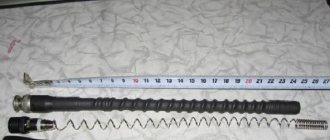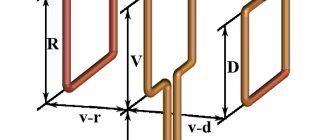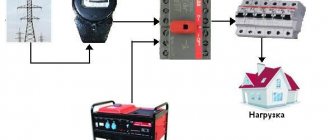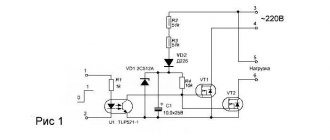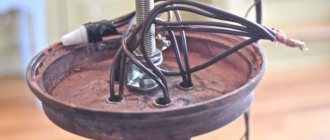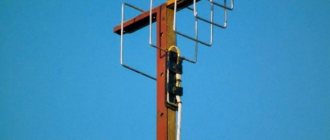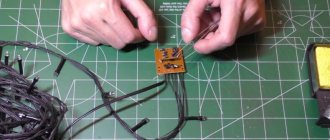Real craftsmen differ from ordinary people in that they do not run to the store when necessary, but try to build the necessary device themselves. At the same time, they often produce devices that are not inferior in characteristics to factory analogues.
As it turned out, a DIY TV antenna assembled with your own hands perfectly catches the signal from the nearest television tower. Moreover, you can design and assemble many effective functioning devices for home use. In this article we present a selection of the best models with detailed instructions for their manufacture. First, let’s look at their advantages over purchased ones.
Device characteristics
A television antenna is a bipolar device capable of emitting and receiving signals in the meter and decimeter ranges. Modern digital television requires accurate calculation of wavelength indicators, since only in this case is it possible to obtain a high-quality signal.
An analog antenna will pick up any wave, even the weakest one, while a digital one will require a clear, stable signal.
Modern TVs are capable of monitoring the level of digital signals themselves. For other devices you will need to calculate everything yourself.
Currently, television can operate at any frequency and on waves of different lengths. In order for a digital antenna created by yourself to function efficiently, it is necessary to adjust its waves in accordance with the transmitting station.
To do this you will need:
- Calculate the wavelength for each package of television channels;
- Determine the maximum wavelength that has the shape of a sine wave;
- Calculate half the length of the wave cross section.
The calculation is made using the formula: L = 300 / F. Where L denotes the length and F the frequency.
DIY digital TV antenna
The antenna design is frame. For this version of the receiving device you will need a cross made of wooden boards and a television cable. You will also need electrical tape and a few nails. All.
We have already said that to receive a digital signal you only need a decimeter terrestrial antenna and a corresponding decoder. It can be built into televisions (new generation) or made as a separate device. If the TV has the function of receiving a signal in the DVB T2 code, connect the antenna output directly to the TV. If your TV does not have a decoder, you will need to purchase a digital set-top box and connect the antenna output to it, and connect it to the TV.
How to decide on a channel and calculate the perimeter of the frames
Russia has adopted a program according to which towers are constantly being built. By the end of 2015, the entire territory should be covered by repeaters. On the official website https://xn--p1aadc.xn--p1ai/when/ find the tower closest to you. The broadcast frequency and channel number are indicated there. The perimeter of the antenna frame depends on the channel number.
This is what a map of the location of digital television towers looks like
For example, channel 37 broadcasts at a frequency of 602 MHz. The wavelength is calculated as follows: 300 / 602 = 50 cm. This will be the perimeter of the frame. Let's calculate the other channel in the same way. Let it be channel 22. Frequency 482 MHz, wavelength 300 / 482 = 62 cm.
Since this antenna consists of two frames, the length of the conductor should be equal to twice the wavelength, plus 5 cm for the connection:
- for channel 37 we take 105 cm of copper wire (50 cm * 2 + 5 cm = 105 cm);
- for channel 22 you need 129 cm (62 cm * 2 + 5 cm = 129 cm).
Maybe you are more interested in working with wood? How to make a birdhouse is written here and about making a doghouse - in this article.
Assembly
It is best to use copper wire from the cable that will then go to the receiver. That is, you take the cable and remove the sheath and braid from it, freeing the central conductor of the required length. Be careful not to damage it.
Next, we build a support from boards, as shown in the figure. To do this, you need to determine the length of the side of the frame. Since this is an inverted square, we divide the found perimeter by 4:
- for channel 37: 50 cm / 4 = 12.5 cm;
- for channel 22: 62 cm / 4 = 15.5 cm.
The distance from one nail to another must correspond to these parameters. Laying copper wire begins on the right, from the middle, moving down and further to all points. Only in the place where the frames come close to each other, do not short-circuit the conductors. They should be at some distance (2-4 cm).
Homemade antenna for digital television
When the entire perimeter is laid, the braid from a cable several centimeters long is twisted into a bundle and soldered (wound if soldering is not possible) to the opposite edge of the frame. Next, the cable is laid as shown in the figure, wrapping it with electrical tape (more often, but the laying route cannot be changed). The cable then goes to the decoder (separate or built-in). The do-it-yourself antenna for receiving digital television is ready.
How to make an antenna for digital television with your own hands - another design - is shown in the video.
Selecting a location and connecting
Determining where to install the antenna usually depends on how it is connected. Placement can be indoor or outdoor. It should be understood that the external option involves more convenient signal reception.
- An outdoor antenna is usually mounted on the roof so that there are fewer obstacles in the form of walls and other buildings.
- But we must not forget that the clarity of the signal largely depends on the length of the cable. The larger it is, the lower the quality of transmission.
- An indoor antenna works best if there is a clear signal. Owners of dachas and country houses are looking for compromise options.
Experts recommend measuring signal quality with special instruments that can help eliminate errors in equipment placement.
Calculation
- Go online by typing “rtrs.rf map” in the search box.
- In the “address” box, indicate your locality.
- Data about the package of RTRS 1.2 TV channels will appear. Add the resulting values and divide in half (you get the average amount).
- Using the wavelength formula, you need to divide the speed of propagation of the radio wave by the frequency: L=V/T.
- Round the resulting number to the nearest 10th, dividing by 2.
The resulting value is the length of the wire to make an indoor TV antenna with your own hands.
Coaxial cable device
The simplest option for a self-made antenna is considered to be a product made from coaxial cable. Equipment can be manufactured quite quickly and without special training.
This antenna receives channels in the UHF range. In addition to the cable, to assemble the product you will need a piece of plywood or other sheet material to create a platform on which the device will be mounted.
You will also need cutting tools and electrical tape. Next you need to follow the instructions:
- Cut a piece of cable a little more than half a meter long and bend it into a ring without connecting the ends. Secure it like this to the base.
- Use another piece of cable (0.175 m) as a loop and connect.
- At the other end of the cable, install a connector for connecting to the TV.
The antenna is ready to receive the signal, but may be too weak. In this case, you will need to purchase an amplifier unit. You can also complicate the product by wrapping the cable in a figure eight.
Necessary materials and tools for manufacturing
Rod, wire, copper or thin-walled aluminum pipe are good materials for making a digital antenna. Any conductive materials are suitable - metal strips, aluminum corners, etc.
The properties of coaxial cable are similar to copper. However, it costs much less and is stronger, which is important for the three-dimensional design of a television antenna. Everyone has pieces of such wire or illiquid material in their household.
To create, you may need tools: pliers, a knife, washers, self-tapping screws, a soldering iron, a drill, a screwdriver, and a glue gun. For flat structures, a non-conducting material is used for the substrate - plywood or similar.
Figure 8 antenna
Another version of the simplest device for receiving a television signal is a figure-of-eight antenna. The photos of the antenna presented give an idea of why this name was chosen.
The available materials are: a thick cardboard box, a special cable, a tip for connecting to a TV, a soldering iron, electrical tape, foil, glue, cutting tools.
The manufacturing process consists of several stages:
- Cover the bottom of the box with foil so that it serves as a signal reflector.
- Close the box and attach a figure-of-eight cable to the lid.
- From the middle part of the figure eight, bring out two ends to connect the product.
- Connect one end of the conductive cable to the TV using a connector, and run the other from the screen to the central core.
- Connect the ends of the cable to the exposed ends of the figure eight.
The figure-eight antenna is ready for use. It can provide a high-quality digital signal that is not inferior to satellite.
Let's make the antenna a frame
If you need to make an antenna for a TV in a different way, then it’s worth considering another simple option. We will use aluminum plates and metal mesh to make the reflector.
A part from a damaged barbecue maker would be suitable. Additionally you will need: bolts and nuts, rivets for securing frame elements, a cable based on a plug, a drill, a screwdriver with pliers.
Manufacturing process:
- We take aluminum strips of a suitable size. Holes are drilled at the ends for bolting.
- The product is assembled in the form of a frame. The connections of the parts are secured using the overlapping method. To prevent oxidation, the fasteners are coated with varnish or paint.
- The frame is connected to a cable to connect to the TV.
- The frame is attached to the reflector, but it should not short-circuit the electrical circuit of the antenna.
- The product is mounted on a mast and placed in the most advantageous place for signal reception.
If it is impossible to catch a good signal, then an amplifier is included in the design. Typically, this problem occurs when there is a significant distance from the television tower repeater.
Device made from aluminum cans
A fairly popular antenna model is made from simple aluminum drink cans. The containers have a lot of advantages, as they have a sufficient area when unfolded, have good conductivity close to copper, and have a streamlined shape that reduces windage. The main advantage is the absolute availability of the material.
In addition to the aluminum parts, you will need 10 m of high-quality television cable with a durable central core and a continuous double braid. You also need to prepare a wooden hanger, fasteners, electrical tape and a soldering tool. Then, following the instructions, you can begin assembly:
- First, the cable is prepared. It is cut at one end and partially cleared of the insulating coating.
- The inner copper core is then released.
- The opposite end is equipped with a nozzle for connecting to TV.
- The contacts, freed from insulation, are soldered to the banks.
- The cans are fixed in one line on the hanger using electrical tape at a distance of 7.5 cm.
It is better to place an antenna made from cans on a window. It will work especially well if there are no high-rise buildings between it and the station.
Making your own television equipment is a great way to save money and an opportunity to acquire the necessary equipment. You can make your own Wi-Fi antenna, designs for analogue or digital television.
How to make an antenna
First of all, you need to determine the size of the antenna. The coaxial length depends on the broadcast frequency of the television channel and is based on 2 important parameters:
- wave speed in vacuum equal to 300,000,000 m/s;
- TV signal reception frequency lying in the range of 500-800 MHz.
The wavelength in the cable is calculated by the formula: L=300/F. The result of the antenna loop length is obtained in meters. With a digital signal, it is enough to make a design that is more broadband.
Digital encoding is insensitive to interference, but if the air is polluted, signal mismatch can lead to blurred images. The image may freeze or become scattered.
To reduce the harmful effects of interference, a reflector is built behind the antenna - a signal reflector. Any metal or foil-coated surfaces are suitable - metal sheets, packaging, foil and others. It is recommended to paint external antennas and solder all connections - this reduces corrosion and reduces oxidation of conductors. To create a highly directional antenna, the reflector is made in the form of a parabola. This helps with weak signal levels.
From coaxial cable
A powerful antenna for a TV is constructed from 50 cm of ordinary RK-75 cable. The braid may consist of foil or metal mesh. One stripped end of the cable is connected to the TV through a connector into the TV socket. The other end is for creating an antenna.
Remove the winding from the edge, free the cable shield. Twist the screen cores into a separate bundle. Separate the central core.
In the second step, measure 22 cm from the prepared edge and strip 2 cm of outer insulation with screen and braid. In this case, the insulation of the central core remains undamaged.
The third stage of manufacturing is cutting through the outer layer of insulation to the foil again after 22 cm.
After this, we twist the cable into a ring, connecting the first prepared end to the last. Now you have a powerful antenna, made entirely yourself and practically from garbage.
After connecting, we start setting up channels. The best location for the device will be the space outside the window, and the direction will be towards the TV tower. Nearby buildings may muffle or distort the signal, so you'll have to experiment with direction and location.
In the form of a frame
You will need aluminum plates, a reflector mesh from a barbecue or plaster, bolts, nuts, rivets, a cable from an old antenna with a plug, a drill, a screwdriver, and pliers.
Manufacturing process:
- Cut aluminum strips. Drill holes for bolts at the ends and in the middle. The length of the plates is 328 mm at the centers of the bolt holes.
- Assemble the diamond-shaped frame in such a way that in a large diamond, 2 more rhombuses located inside come out from the middle of the plates. The size of their sides at the centers of the holes is 180 mm. The fastening points are soldered or varnished to prevent oxidation.
- The inner diamonds should not touch. The distance between them is the width of the plate.
- A feeder cable with an antenna connector is connected to the ribs of the inner diamond.
- Reflector size - 570*570 mm.
- We attach the antenna to the reflector without short-circuiting the structure.
All this is installed on a high mast or wall of the house.
Butterfly shaped
The “butterfly” antenna is a simple indoor antenna for a TV at home. To create, you will need a few tools and materials:
- plywood and board 600*70 mm, up to 20 mm thick, for structural rigidity;
- copper wire with a diameter of 4 mm with core shielding;
- coaxial cable 75 Ohm;
- soldering iron, several self-tapping screws with washers.
Manufacturing stages:
- Cut 8 pieces of wire, 37.5 cm each. In the center of each, remove 2 cm of insulation. The center is 17.75 cm from the edge.
- Bend in a V shape with a distance of 7.5 cm between the ends of the “horns”.
- Cut 2 pieces of wire 22 cm each. Break each into 3 equal parts and strip the insulation from the shielding layer.
- Prepare 2 small pieces of wire to connect to the TV socket.
- Assemble all the elements and solder the cable to the plug.
- Place the structure on a prepared piece of plywood, like on a stand.
This is how a butterfly antenna for digital TV is made quite simply.
Figure-of-eight antenna
A do-it-yourself home TV antenna in the shape of a zigzag figure eight will help you catch a signal in the most remote village, of which there are many in our big country. To make an outdoor digital antenna, you will need the following materials:
- Any antenna amplifier. Possibly from a broken old antenna.
- A pair of pieces of copper wire, each 1.8 m long.
- Mounting plate 15*15 cm made of wood or metal.
- TV cable.
- Sturdy mast for raising the antenna.
To create a receiving circuit, we form two rhombuses from wire with sides of 45 cm each. We attach the ends of the elements to the plate - we twist a ring from the core, screw it with bolts and solder it.
We connect the amplifier and insert the plug of the prepared cable into the TV connector. We have a ready-made antenna circuit in our hands. All that remains is to raise it higher above the ground and orient it correctly. After orientation and testing of the new acquisition, the mast is securely fixed in the ground or attached to the building.
Instead of copper wire, you can use any conductive material: metal strip, copper or aluminum tubes, corners. Their thickness should be from 1 to 5 mm.
From metal cans
Even aluminum cans of Coca-Cola or beer are suitable for making a receiving wave device. A receiving device made from these materials will not be powerful, but it will be possible to catch several channels, not only in the decimeter range, but also in the meter range.
The jars are taken clean, dry, with smooth walls without ribs. The design is very simple: a pair of cans are soldered to the cable and placed on a wooden base on both sides of the cable.
For better signal reception, several lines of cans are created. The optimal number is 3; a larger number is difficult to agree on. For production we will prepare materials:
- 5 m TV cable “RK-75”;
- Non-conductive base made of wood or plastic;
- Self-tapping screws, insulating tape and soldering iron.
Proper preparation of the TV cable:
- at a distance of 10 cm from the edge, the top layer of insulation is removed;
- the inner shielding layer is woven into a bundle;
- on the same side the central vein is exposed;
- a plug is connected to the other end of the cable;
We connect the cable to the banks. To one can there is a central core, to the other there is a bundle of their shielding mesh or foil. The joints are soldered.
You can attach jars to the base in different ways. Double-sided tape, a glue gun, or other fixing material will do. The main thing is that the jars are the same size and at the same distance in width and height. The distance, installation location of the antenna, and the height of the elements are selected experimentally using a “scientific poke” method.
An antenna amplifier is used to improve signal quality. You can improve the quality of reception by creating a structure of several shields with cans. The main thing is to remember that the longer the TV cable, the weaker the signal. This is especially true for long waves.
Photo of a homemade antenna
The nuances of making signal catchers
When starting to make a homemade device, you need to have an idea of the possible design options and the rules for their assembly.
The entire variety of television antennas is usually divided into several types:
- All-wave . A frequency-independent antenna is the cheapest and easiest to manufacture. The base is a metal frame, and tin containers or beer cans are used as receivers. The design does not have high performance parameters, but it is quite suitable for a summer residence if the broadcast tower is located nearby.
- Log-periodic . The principle of operation is comparable to a fishing net that sorts prey during catching. The device is easy to manufacture, and its parameters exceed those of all-wave models. The antennas are consistent with the feeder in any range.
- Decimeter . Designs that function well regardless of reception conditions. Various designs are possible: zigzag, diamonds, circle, etc.
- The central core and braid are made of inexpensive alloys that are resistant to corrosion processes. However, they are difficult to solder - work is carried out with extreme caution so as not to burn the wire.
- To connect elements, you need to use a 40 W soldering iron, flux paste, and low-melting solder.
- It is not advisable to use aluminum wire to create structural parts. The material quickly oxidizes, losing its ability to conduct a signal. The best option is copper, an affordable alternative is brass.
The antenna parts through which the useful signal currents run are joined by welding or soldering. However, when placing the device on the roof of a house, such contacts will be corroded over time by corrosion.
One of the conditions for sufficient purity and stability of reception is the minimum number of joints in the design of the signal catcher
In addition to this norm, when creating an antenna for a summer residence with your own hands, it is advisable to adhere to the following rules:
The receiving area of the catcher must be large. In order to increase it, metal rods can be symmetrically attached to the frame that filters out ethereal noise.
Connecting the simplest signal amplifier to the antenna will significantly improve the quality of broadcast transmission. Factory products are already equipped with this element
A tandem of a homemade antenna and amplifier will provide the necessary receiving power. It is enough to take the structure onto the roof and install it in the direction of a nearby television tower.
Why do you need to calculate an antenna?
Taking into account the tasks that the antenna must perform, it is possible to assemble an all-wave device or a device operating in a specific range. Moreover, the difference between them is quite significant. Universal antennas receive weakened signals noticeably worse, especially those that are jammed by the background of more powerful radiation. Devices operating in the same range are not so picky about the quality of waves.
The task is further complicated by the fact that it is very difficult, and sometimes simply impossible, to check the quality of the received signal after assembly. In the case of an analog antenna, everything is simple: albeit with interference, it will pick up even weak echoes of the repeater. Whereas digital TV requires a stable and clear signal, otherwise there will be no image at all, not even noise. And after assembling the equipment, it is not clear what the problem is: in the antenna, receiver or cable.
Modern smart TVs have functionality that shows the quality level of the current digital signal, which makes it much easier to choose the format of the future antenna, as well as its installation. Other devices do not have such capabilities. Therefore, it is so important to carry out the calculations correctly, thereby eliminating problems with the antenna.
Check and installation
After assembly, you should pay attention to the place where the antenna is installed.
For reliable reception, there should be no buildings or large trees in the line of sight of the transmitting tower. After this, you need to choose the direction of the antenna such that the signal is maximum.
